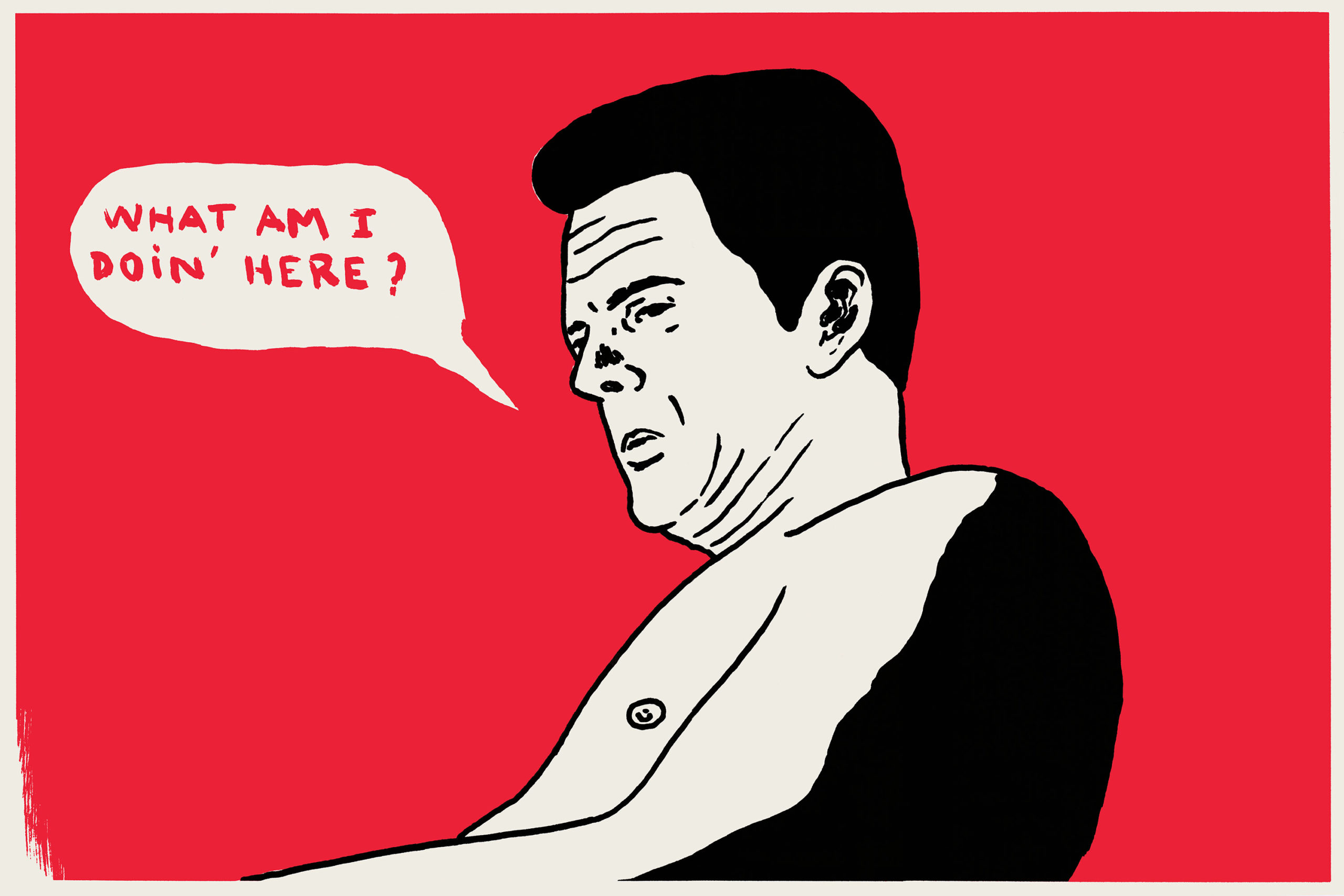
Pierre La Police
Tes monstrueux autocollants qui brillent dans la nuit...
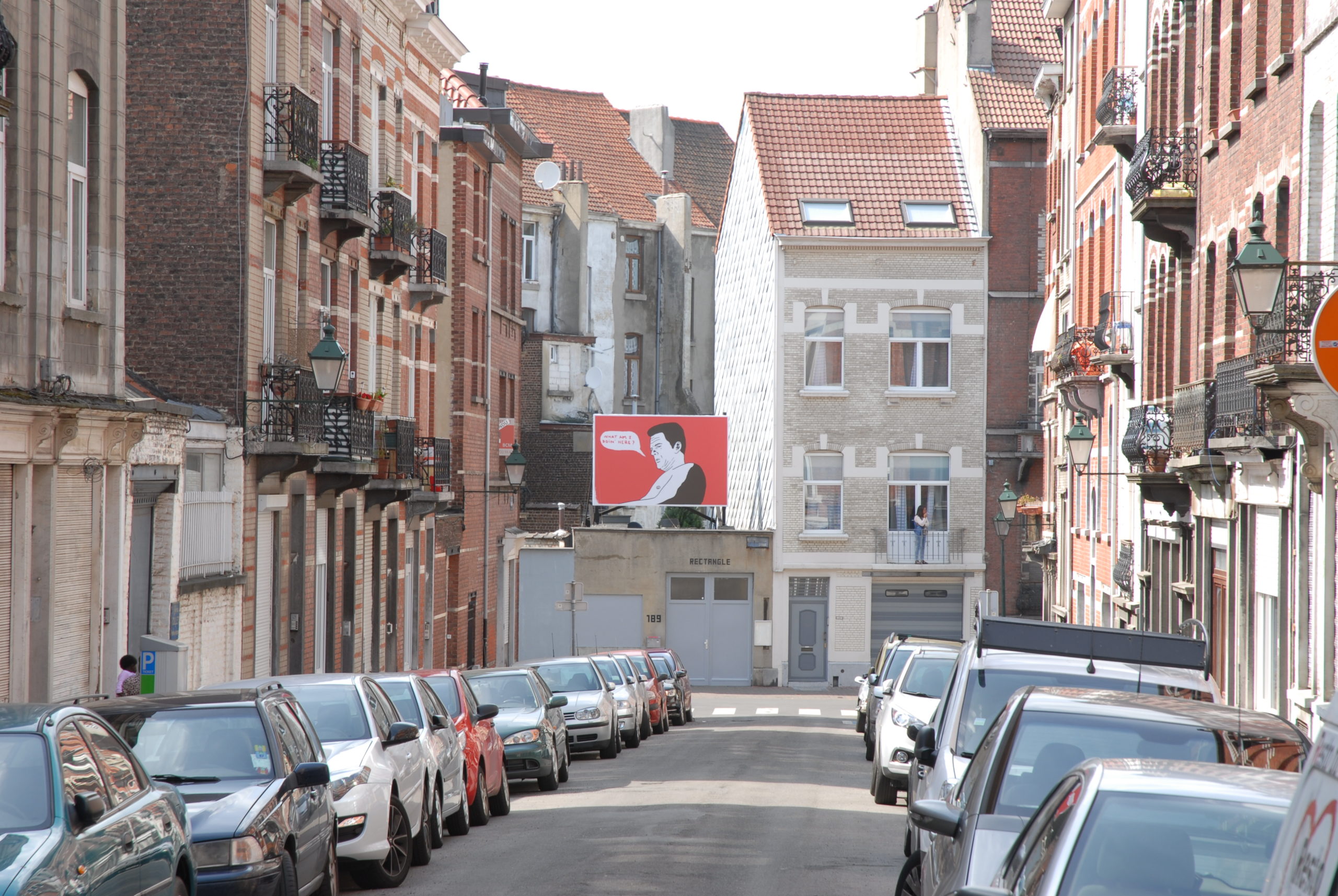
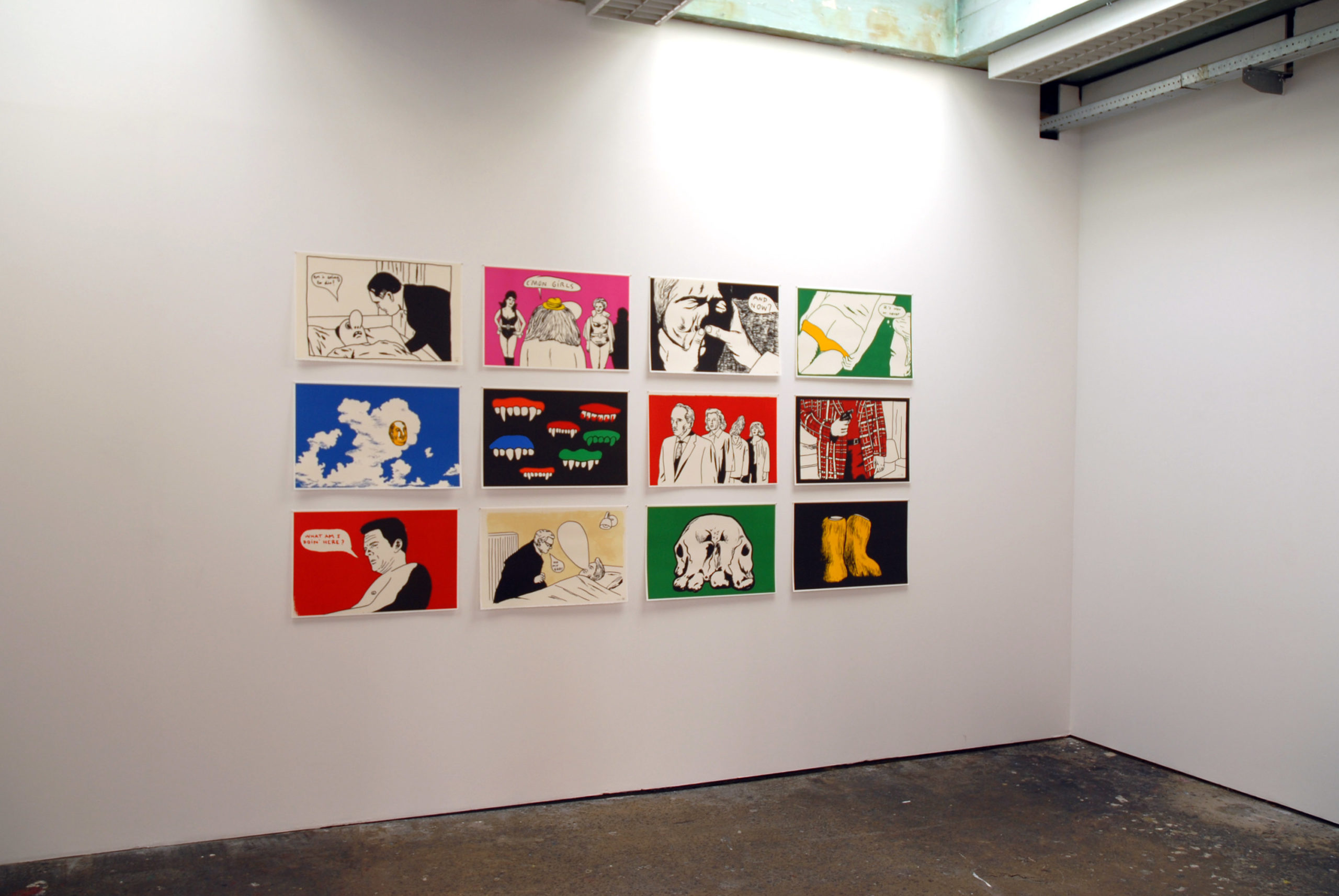
Cult cartoonist, rebel and iconoclast, Pierre La Police is a contemporary artist defying classification. His work is sourced, and finds critical power, in the narrative processes of comic strips, and more generally in the formal aspects of media spin and popular culture.
For Rectangle, PLP puts forward an image that originates from a series of 12 prints, enlarged for a public space setting and offering the passer-by as much an opportunity for reflexive questioning as for a smile.
The result of the most careful printing work, each 62×40 cm-formatted board develops the humorous universe of Pierre La Police, an uncategorizable yet recognisable artist. The images either focus on an incongruous detail (hairy yellow boots) in the style of a movie close-up, or on a ‘malfunctioning’ cutaway (a gangster where neither head nor feet are captured but only his middle), or a scene straight from an obscure cartoon strip (a low angled shot of a man proclaiming “what am I doin’ here?”). Some boards portray a surreal world: a man’s head fluttering around a smoky cartographic landscape, a fixed grin with exaggerated teeth evoking nightmarish scenes, a hybrid form hesitating between the animal and mineral kingdoms. The strange frames disrupt representations that are no less so.
Worrisome (a doctor leans on a deformed being who asks “Am I going to die?”), situations quickly become grotesque or mysterious, laughable in their perplexity. Boards resting on unstable affects create an inimitable atmosphere. Absurd details conspicuous in their density, make one think of David Lynch, but with Pierre La Police tension turns to a rare kind of fantastical, off the wall comedy. An immediate unity in form links these incongruous scenes: flat monochromes, mostly confident black lines, the random presence of speech bubbles. Weird and clichéd (surfers, bureaucrats, pin-ups), Pierre La Police’s characters are types of human. They live alongside implausible and misshapen beings that have gently infiltrated them. Thus, on a blood red background, out come four figures from a 1950s works council, but one of them is an alien imposter. The purpose of this simple art, although marked with deliberate awkwardness, is to threaten an all too peaceful reality by incessantly sabotaging normality. To this end, Pierre La Police, likes to mix legitimate and brut art forms, popular and underground; cinema, comics, desktop wallpaper, fotonovelas, stickers etc. The contrast between the quality of the boards and the cheap, derisory imagery they depict works perfectly. From spanning print offsetting to the noble art of lithography, Pierre La Police wins poetic gravitas.
Thomas Clerc – Janvier 2008
Dessinateur culte, hors-la-loi et iconoclaste, Pierre La Police est un artiste contemporain inclassable dont le travail trouve sa source et sa puissance critique dans les procédés narratifs de la bande dessinée et, d’une manière plus générale, dans les aspects formels du langage des médias et de la culture populaire.
Pour Rectangle, PLP propose une image issue d’une série de 12 estampes qui, agrandie au format de l’espace public, offre au passant l’occasion d’un questionnement réflexif autant que celle d’un sourire.
De format 62×40 cm, chacune des planches, fruit d’un travail d’imprimerie des plus soignés, décline l’univers drolatique de Pierre La Police, artiste inclassable et pourtant identifiable. Les images se focalisent soit sur un détail incongru (des bottes en poils jaunes) à la manière du close-up de cinéma, soit sur un plan de coupe « raté » (un gangster dont on ne voit ni les pieds ni la tête est saisi par le milieu), soit sur une scène tirée d’une bande dessinée obscure (un homme en contre-plongée déclare « what am I doin’here ? »). Certaines planches dessinent un monde surréel : une tête d’homme volette dans un paysage cartographique en fumée, des rictus à la dentition outrée évoquent des scènes de cauchemars, une forme hybride hésite entre règne minéral et animal. Les cadrages étranges perturbent des représentations qui ne le sont pas moins.
Inquiétantes (un médecin se penche sur un être difforme qui demande « am I going to die ? »), les situations tournent vite au grotesque ou à l’énigmatique et font rire en déroutant. Comme chaque planche repose sur des affects instables, une ambiance inimitable s’installe. Les détails saugrenus, saisis dans leur densité, font parfois penser à David Lynch, mais chez Pierre La Police la tension se résout dans un comique d’une nature rare, onirique, décalée. Une unité plastique immédiate relie ces scènes incongrues : à-plats monochromes, traits noirs plus ou moins assurés, présence aléatoire de phylactères. Bizarroïdes ou surconnotés (surfeurs, bureaucrates, pin-ups), les personnages de Pierre La Police sont des sortes d’humains. Ils cohabitent avec des êtres invraisemblables et difformes qui les auraient contaminés en douce. Ainsi, sur un fond rouge sang, quatre figures sorties d’un comité d’entreprise des années 50 se détachent, mais l’un d’entre eux est un infiltré extra-humain. Le propre de cet art épuré quoique empreint d’une maladresse concertée, est de menacer la réalité trop tranquille par un incessant sabotage de la normalité. Pour ce faire, Pierre La Police aime à mixer des arts légitimes et dégradés, populaires et confidentiels : cinéma, comics, fonds d’écrans, romans-photos, vignettes, etc. Le contraste entre la qualité des planches et l’imagerie cheap ou dérisoire qu’elles convoquent fonctionne parfaitement. En passant de l’offset au noble art de la lithographie, Pierre La Police gagne en force poétique.
Thomas Clerc – Janvier 2008
Cult-tekenaar, wetteloos en iconoclast – Pierre La Police is een niet te categoriseren hedendaags kunstenaar. De bron en de kritische kracht van zijn werk situeren zich in de naratieve procedures van het stripverhaal, en meer in het algemeen in de formele aspecten van media-taal en populaire cultuur.
Voor Rectangle stelt PLP één beeld voor uit een reeks van 12 prints, die – uitvergroot en aangepast aan de publieke ruimte – zowel kritische reflectie als een lach teweegbrengt.
Elke print , telkens 62 x 40 cm, het resultaat van een verzorgde grafische aanpak, toont het grappige universum van PLP- niet te categoriseren en toch herkenbaar kunstenaar.
De beelden concentreren zich op bizarre details (vb. Laarzen van gele vacht) in een stijl die gelijkaardig is aan close-ups in cinema. Gerateerde cadrages (vb. Een gangster waarvan we de voeten noch het gezicht zien.), of scenes uit obscure stripverhalen (vb. Een man gezien vanuit kikker perspectief verklaart ‘What am I doin’here ?’)
Sommige prints tonen een surreële wereld : Het paarse hoofd van een man in een cartografisch landschap dat baadt in rook, een grijns die een nachtmerrie doet ontstaan, een hybride vorm die twijfelt tussen mineraal tijdperk en dierenrijk…. Cadrages die er voor zorgen dat de representatie op de helling komt te staan.
Verontrustende scenes(een arts die zich over een vervormd wezen buigt dat zich afvraagt ‘am I going to die ?’) die nijgen naar het groteske of enigmatische en tegelijkertijd doen lachen.
Elk beeld uit de reeks is gebaseerd op een instabiele aantrekking en installeerd een onnavolgbare sfeer. De vreemde gecondenseerde details doen soms denken aan David Lynch, doch bij PLP lost de spanning zich op in een vreemde komische aard, droomachtig, verplaatst en vervreemd. Een plastiche directe éénheid verbinden bervreemdende scènes. Monochrome vlakken, zwarte sporen die min of meer verzekerd aandoen. Rariteiten en zeer bepaalde groepen (vb. Surfers, bureaucraten, pin -ups etc.)- de personnages van PLP zijn ‘een bepaalde soort van mensen’. Ze leven samen met vreemde en vervormde wezens die hen besmetten.
Op een bloedrode achtergrond, 4 personages uit de jaren ‘50 die net een bedrijfsvergadering hebben verlaten, waarvan één onder hen een geïnfiltreerd buitenaards wezen is. De eigenschappen van dit werk zijn de combinatie van uitgezuiverde plasticiteit en bewuste onhandigheid, en het aanvallen van een te rustige realiteit door het saboteren van normaliteit.
PLP vermengt legitieme en gedegradeerde kunst- populair en vertrouwde media : cinema, strip, screensavers, foto romans, etc… Het contrast tussen de plastische kwaliteit van de prints en de goedkope of inwisselbare beeldtaal werkt perfect. Door het vertalen van populaire offset techniek naar lithografie wint het werk van PLP aan poëtische kracht.
Thomas Clerc – Janvier 2008
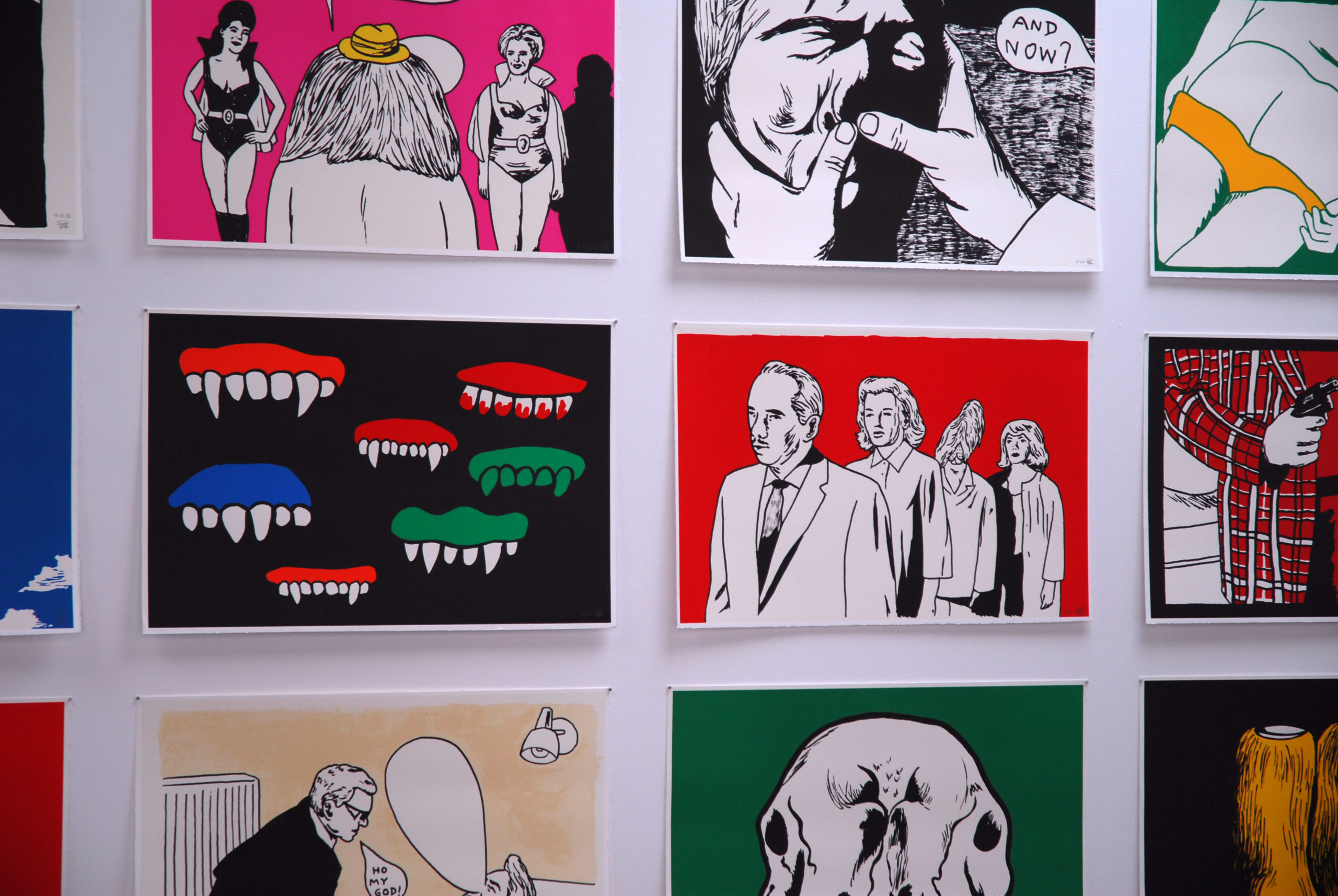

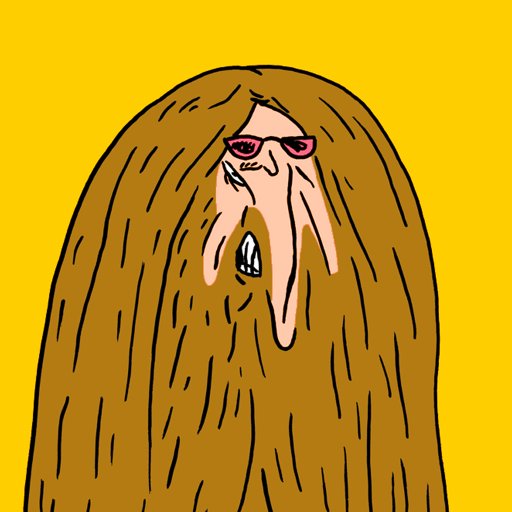
Pierre La Police
Born in 1959 in France.
Lives and works in Paris.
www.pierrelapolice.com